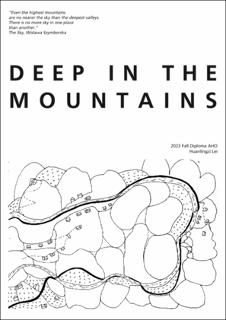| dc.description | My hometown is a small city in Guizhou Province in southeastern China. Sometimes I dream about things taking place there. The connections become stronger when I am farther from there. Since I worked in one of the biggest metropolitan cities, Shenzhen, I have been thinking about how I can be an architect in my hometown. Even though architects are an unnecessary profession in the small city, the connection with this land leads me to make architectural attempts.
Urban explorer Rem Koolhaas warned us about the dying of rural in the Guggenheim exhibition Countryside, The Future. The countryside is an all-time topic, with political Rural Vitalization, civic Rural Reconstruction, and artistic interventions, but I am more interested in why some people are deeply rooted in villages where many traditions rest. Sibyl Moholy-Nagy1 and Juhani Pallasmaa2 both mentioned T.S.Eliot’s essay “Tradition and the Individual Talent” (1919). In this essay, Eliot argues that about how inheriting tradition cannot be inherited, and if you want it you can only needs obtained it by great labor.3 Tradition is necessary for us in order to maintain identity and connection in the world. It has however to re-created and re-invented, as Pallasmaa says. How can we access traditions and villages?
The village where my father came from is the initiative for this diploma project. It is about everyday life in an inclusive mood with the landscape around it. I made the word “Villopia” up with village and utopia. It is a concept of reconstructing utopian life in a village and making it accessible for those who are far from it to understand. This view is based on my memories, experiences, and observations, which are the main tools for “looking at” connections in an ordinary, disappearing village. I depict the mood of viewing the topography and being in the landscape. All the interpretations become memory journeys. It catches traces of lives through architectural approaches and demonstrates how we live with the vicissitudes of time in the spaces. Villopia experiment is launched as an architectural test for bringing village lives to an urban area. A flora table is made in this experimental renovation project to connect people there with here, the past with the present, and people with flora.
The whole project is to register things in a normal village. In Deep in the Mountains, the pre-diploma provides different perspectives to look at villages and architectural program for the diploma. In Villopia – The Portrait of a Village, different drawings and models are the new portraits to get to know the village. Living with Flora is an experimental project to realize rural lives in urban areas. Materials of working process and inspirations are also included. Architecture and landscape become performance stages for living beings’ lives. Invisible traditions are continued through the life performance. As an architect, I can’t stop the loss of the village, but registering is what I can do for everything living in the village. | en_US |

